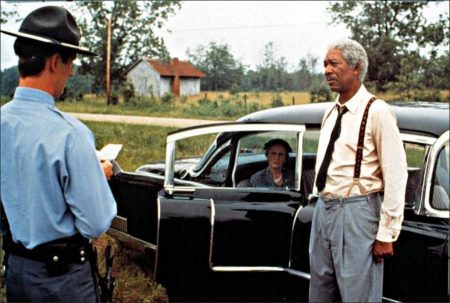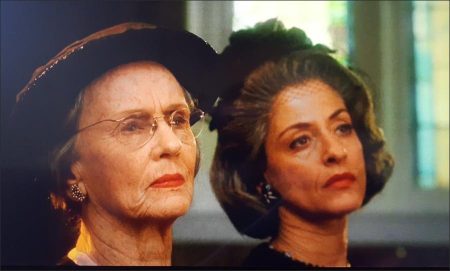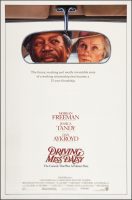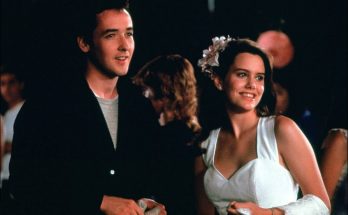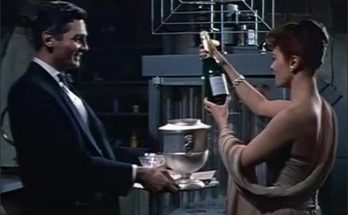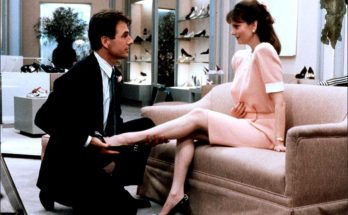Taglines: The comedy that won a Pulitzer Prize.
Driving Miss Daisy movie synopsis. An elderly Jewish widow living in Atlanta can no longer drive. Her son insists she allow him to hire a driver, which in the 1950s meant a black man. She resists any change in her life but, Hoke, the driver is hired by her son. She refuses to allow him to drive her anywhere at first, but Hoke slowly wins her over with his native good graces. The movie is directly taken from a stage play and does show it. It covers over twenty years of the pair’s life together as they slowly build a relationship that transcends their differences.
Driving Miss Daisy is a 1989 American comedy-drama film directed by Bruce Beresford and written by Alfred Uhry, based on Uhry’s play of the same name. The film stars Jessica Tandy, Morgan Freeman, and Dan Aykroyd. Freeman reprised his role from the Original Off-Broadway production. The story defines Daisy and her point of view through a network of relationships and emotions by focusing on her home life, synagogue, friends, family, fears, and concerns over a 25-year period.
At the 62nd Academy Awards in 1990, Driving Miss Daisy received nine nominations, and won the Academy Award for Best Picture, Best Actress (Jessica Tandy), Best Makeup, and Best Adapted Screenplay.
Film Review for Driving Miss Daisy
”That car,” says Miss Daisy, ”misbehaved.”
”Cars don’t misbehave, Mama,” says Boolie Werthan. ”They have to be caused to misbehave.”
That morning Miss Daisy (played by Jessica Tandy) had been inching out of her Atlanta driveway when the car suddenly zoomed back across the flower beds, up and over a small retaining wall, so as to teeter, with its rear end exposed, over her neighbor’s yard.
Miss Daisy had put her foot on the gas instead of the brake, though Boolie (Dan Aykroyd) has the good sense not to accuse his mother of the obvious. She’s not around the bend yet. Miss Daisy is in her 70’s and has all her faculties. She has, however, reached a point where cars tend to misbehave when she is behind the wheel.
Against his mother’s furious objections, Boolie decides it is time she had a man to drive for her. It is his great good fortune to find Hoke Colburn (Morgan Freeman), a black man in his 60’s, a widower who is patient and has infinite tact and vast reserves of subversive wit.
Thus begins Bruce Beresford’s gently opened-up screen version of ”Driving Miss Daisy,” Alfred Uhry’s fine Pulitzer Prize-winning play, which is still running Off Broadway at the John Houseman Theater.
Plays, especially small ones, do not always open up with ease on the big movie screen, but ”Driving Miss Daisy” carries most of its cinematic options with great style. It is the most successful stage-to-screen translation since Stephen Frears turned Christopher Hampton’s ”Liaisons Dangereuses” into ”Dangerous Liaisons.”
Mr. Uhry, who wrote the screenplay, has supplemented the play’s three characters with people who are only talked about on the stage. They are introduced with care and so discreetly characterized that they do not impinge upon the central relationships that give the play its strength.
Mr. Uhry’s job was easier than the task most playwrights face when doing stage-to-screen adaptations. His play is comparatively free of form to start with. It uses a minimum of props within a single all-purpose set that comes to represent Miss Daisy’s house as well as locations all over Atlanta and its environs. To a certain extent, his play was already opened up.
Even so, there is an exhilarating, singularly theatrical lightness of touch that is often lost when these settings are made manifest in a movie. Mr. Beresford and Mr. Uhry, working in concert, see to it that the essential spirit of ”Driving Miss Daisy” shines through the sometimes deadening effects of literalism.
This ”Driving Miss Daisy” is small and pure and healthily skeptical as it chronicles, from a privileged position, the social changes taking place in the South between 1948 and 1973, and the remarkable 25-year friendship that embraces those changes.
On one side is Miss Daisy, the rich Jewish widow who hates being called rich and loathes the whole idea of servants. ”I don’t have any privacy,” she complains to Boolie. ”It’s like having children in the house.”
On the other side is Hoke, who knows far more of the real world than Miss Daisy and remains steadfastly unsurprised by it. To Hoke’s amusement, Miss Daisy clings with tenacity to the memories of her humble beginnings on the wrong side of the tracks, and to her years as a schoolteacher. Among other things, she teaches him how to read. He teaches her about the world he inhabits, which, when the privileges are removed, is not so different from hers.
She is almost impossible to deal with in the early years, but Hoke plays her as if he were a benign angler. She finds fault everywhere. Hoke agrees with her and then goes on, in his resolute way, to show her up with such maddening delicacy that she cannot find fault.
Because she is Jewish and he is black, both are outsiders. Mr. Uhry does not press down too hard on this, though it is a fact of life that, at a key moment, provides an unexpected point of alliance. Miss Daisy and Hoke are as much outsiders for their age and sensibility as for anything else. Theirs is the friendship of equals. So is the casting of the two central roles.
In her long career in films, Miss Tandy, always celebrated on the stage, has never had a role of a richness and humor to match Miss Daisy, and she brings to it her mastery of what might be called selective understatement. She is a spectacular accumulation of tiny obsessions and misconceptions. Miss Tandy creates a most particular woman, who is sometimes hilariously wrong-headed but almost always self-aware.
Her Miss Daisy possesses the kind of stubbornness that one hesitates to crack, since, underneath, there is something extremely fragile. Yet there is also a fierce intelligence that comes through, no more movingly than in the film’s final sequence.
Mr. Freeman, who originated the role on the stage, eases through the movie with the sort of humor that has been earned after a lot of hard knocks. Though the character never appears to be tough, it’s a tough performance. It is laid-back and graceful, the work of an actor who has gone through all of the possibilities, stripped away all of the extraneous details and arrived at an essence.
The two actors manage to be highly theatrical without breaking out of the realistic frame of the film. Mr. Aykroyd gives a notably self-effacing performance as Boolie, a role that is in large measure a dramatic device, but also a lot more fully drawn than most dramatic devices in such plays. He is funny, loving and amazingly nonjudgmental, especially when it comes to his wife.
She is the fearfully nouveau riche Florine, played by Patti LuPone with just the right amount of heedless determination. (According to Miss Daisy, Florine’s idea of heaven is socializing with Episcopalians.) Esther Rolle is also good in the brief role of Miss Daisy’s cook and housekeeper.
Some of the ways in which the film has been opened up inevitably coarsen a very delicate work. It is difficult to believe that even Florine, who is, after all, the wife of Atlanta’s businessman of the year, would cover her house with the kind of garish Christmas decorations that would look overwrought at Disney World. It’s a cheap laugh. Also a bit heavy-handed is a scene in which Miss Daisy and Hoke, en route to Mobile, are stopped and questioned by a couple of redneck state troopers. Says one trooper to the other as Miss Daisy and Hoke go on their way: ”An old Jew woman and an old nigger, taking off down the road together. What a sorry sight.”
Driving Miss Daisy (1989)
Directed by: Bruce Beresford
Starring: Morgan Freeman, Jessica Tandy, Dan Aykroyd, Patti LuPone, Esther Rolle, Joann Havrilla, Alvin M. Sugarman, Clarice F. Geigerman, Crystal R. Fox
Screenplay by: Alfred Uhry
Production Design by: Bruno Rubeo
Cinematography by: Peter James
Film Editing by: Mark Warner
Costume Design by: Elizabeth McBride
Set Decoration by: Crispian Sallis
Art Direction by: Victor Kempster
Music by: Hans Zimmer
Distributed by: Warner Bros. Pictures
Release Date: December 13, 1989
Visits: 219
